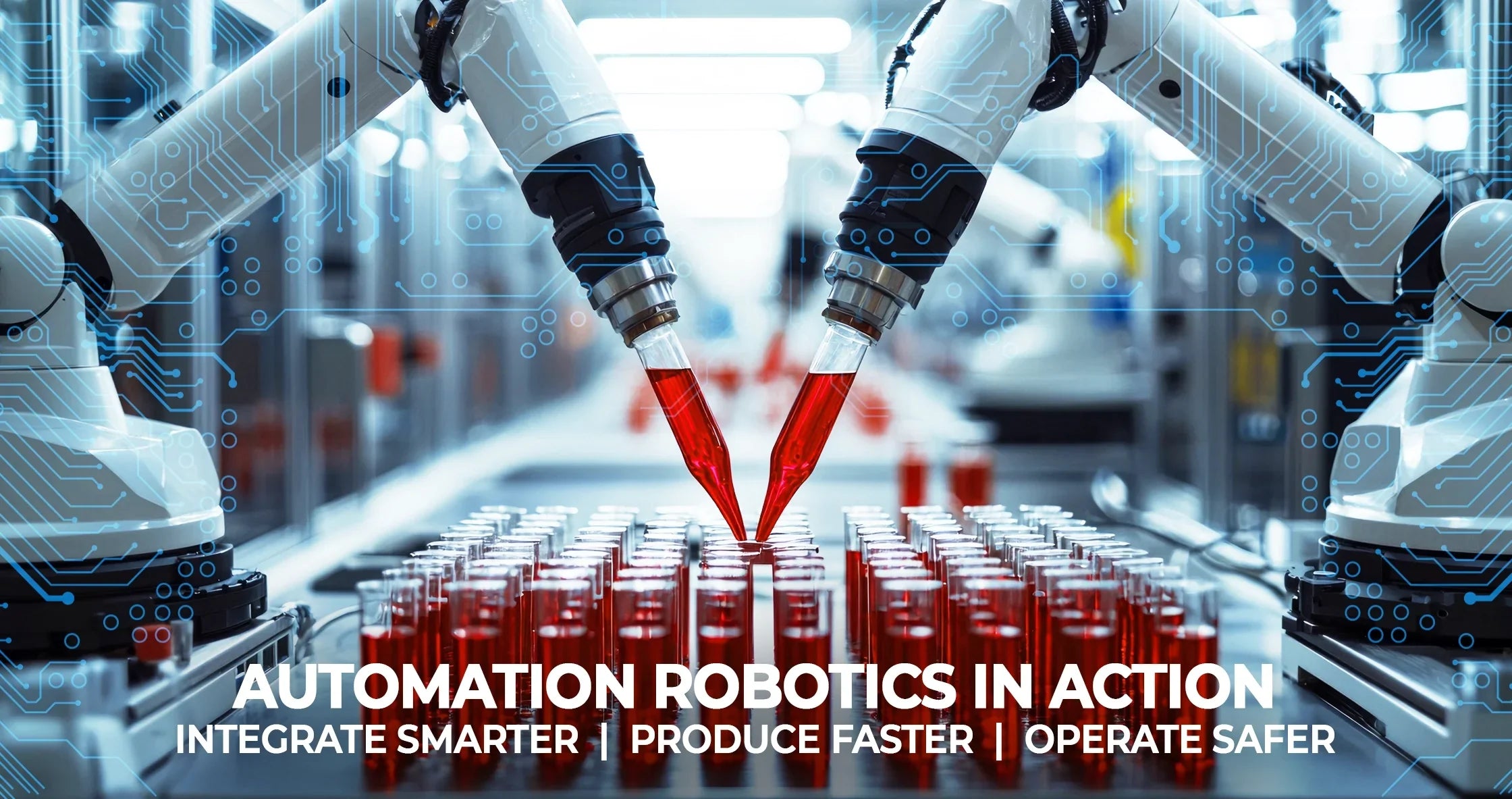In today’s highly competitive manufacturing environment, the drive toward increased efficiency, precision, and safety has made automation robotics a vital part of industrial operations. As technologies evolve, industrial robots have become more adaptable and affordable, making them accessible to companies of all sizes. Whether you're handling repetitive tasks or seeking to improve productivity, integrating robotic systems into your processes can yield significant long-term benefits.
From interfacing with PLCs and control systems to performing complex tasks like material handling and assembly, automation robotics has revolutionized the way manufacturers think about production. In this article, we’ll explore what it takes to integrate robotic systems effectively, outline their core benefits, and provide strategic tips for planning your own automation robotics project.
The Role of Automation Robotics in Modern Industry
Automation robotics refers to the use of robotic systems in industrial and manufacturing environments to automate tasks that were traditionally performed by human labor. These robots are programmed to perform high-precision, repetitive, or hazardous jobs, increasing both output and safety.
Modern industrial robots are capable of performing a wide range of functions, including welding, painting, picking and placing, inspection, packaging, and even delicate assembly work. Their integration into a facility often centers on their seamless communication with programmable logic controllers (PLCs) and centralized control systems.
With automation robotics, companies can optimize their workflows, reduce operational costs, and boost output with minimal errors.
How Robots Interface with PLCs and Control Systems
At the heart of any automation robotics system lies communication—particularly with PLCs and other automation controllers. PLCs (Programmable Logic Controllers) act as the brain of industrial processes, and robotic systems need to integrate smoothly with them to ensure precise control and coordination.
Common Interface Methods:
- Ethernet/IP & PROFINET – Standardized communication protocols used to connect robots and PLCs.
- Digital I/O – Simple, robust, and cost-effective method to transmit basic commands.
- Fieldbus Systems – Allow multiple devices to communicate over the same bus, often used in complex setups.
- Robot Controllers – Serve as intermediaries that interpret PLC instructions and control robotic movement.
Successful interfacing ensures that robotic arms, sensors, and safety systems operate in harmony, thereby reducing downtime and increasing system efficiency. Planning these interfaces in advance can significantly simplify the integration phase of your automation robotics project.
Common Applications of Industrial Robots
The versatility of automation robotics is evident in the sheer number of tasks robots can perform. Here are some of the most common use cases:
1. Material Handling
Robots equipped with grippers or vacuum suction cups are used to move raw materials, workpieces, or finished products from one location to another. This includes palletizing, depalletizing, sorting, and conveyor tracking. Material handling robots are especially beneficial in reducing worker injuries from heavy lifting.
2. Assembly
In industries like electronics or automotive, robots perform intricate assembly operations. From placing small components on circuit boards to fitting parts together with micron-level accuracy, robotic assembly enhances precision and consistency.
3. Welding and Painting
Robotic arms are used extensively in MIG, TIG, and spot welding applications. Their repeatability ensures high-quality welds with minimal variation. In painting, robots provide uniform coating, reducing waste and VOC emissions.
4. Inspection and Quality Control
Vision-guided robots can detect product defects at high speed. Integration with sensors and cameras allows for real-time inspection, helping maintain high-quality standards across batches.
5. Packaging and Palletizing
Automation robotics is key to streamlining packaging operations. Robots can place items into boxes, seal them, apply labels, and stack them onto pallets, enabling faster turnaround times.
6. Machine Tending
Robots can load and unload parts into CNC machines, injection molders, or presses, allowing machines to run longer with fewer interruptions.
Benefits of Adding Automation Robotics to Your Process
Integrating automation robotics into your workflow provides a multitude of tangible benefits:
- Increased Productivity: Robots can operate 24/7 without fatigue, enabling higher throughput.
- Improved Safety: Dangerous or ergonomically challenging tasks are performed by robots, reducing workplace injuries.
- Consistency and Precision: Robots offer unparalleled accuracy and repeatability, minimizing defects.
- Lower Operational Costs: Though initial investment is high, long-term savings on labor and errors are substantial.
- Flexibility: Reprogramming robots for new tasks or products allows manufacturers to adapt quickly to market demands.
Planning a Successful Robot Integration Project
A well-thought-out plan is crucial to maximizing the benefits of automation robotics. Below are key steps to guide your integration process:
1. Define Clear Objectives
Before selecting any equipment, determine the exact problems you're trying to solve. Are you looking to reduce cycle time, eliminate human error, or increase output? Clear goals will guide your equipment and design choices.
2. Conduct a Workflow Analysis
Examine your current processes. Identify tasks that are repetitive, dangerous, or inconsistent. These are ideal candidates for automation.
3. Choose the Right Robot Type
Different robot types are suited for different tasks:
- Articulated Robots: Offer flexibility and multiple degrees of freedom.
- SCARA Robots: Ideal for high-speed pick-and-place tasks.
- Delta Robots: Suited for light, fast operations in food or pharma.
- Collaborative Robots (Cobots): Designed to work alongside humans safely.
4. Evaluate Your Infrastructure
Ensure your facility can support automation. Consider space requirements, network capabilities, safety zones, and power supply.
5. Work with a Qualified Integrator
A system integrator brings valuable expertise in configuring robots, PLCs, and control systems. They can help with programming, safety compliance, and training.
6. Pilot Testing and ROI Measurement
Start with a pilot project to work out bugs and test viability. Measure key metrics such as throughput, defect rate, and labor savings to validate ROI.
7. Train Your Workforce
Invest in training employees to work with and maintain robotic systems. Upskilling your team ensures long-term success and operational stability.
Overcoming Common Challenges in Automation Robotics
Implementing robotic systems is not without its hurdles. Here are some common challenges and how to address them:
- High Upfront Cost: Mitigate by starting small or leasing equipment.
- Resistance to Change: Engage staff early and provide thorough training.
- Integration Complexity: Choose modular robots and experienced integrators.
- Maintenance Requirements: Plan for regular upkeep and part replacement.
The Future of Automation Robotics
As technology advances, automation robotics will continue to evolve. Trends like AI-powered vision systems, 5G connectivity, and cloud-based analytics are enhancing the capabilities of robots, making them smarter and more interconnected.
Cobots are also gaining traction in small and medium enterprises due to their ease of use and flexibility. Future systems will likely emphasize plug-and-play functionality, allowing quicker deployment and reduced downtime.
Sustainability is another driving factor. Robots designed for energy efficiency and minimal material waste will align with growing environmental regulations and consumer preferences.
Conclusion
The integration of automation robotics into industrial processes marks a transformative step toward increased efficiency, precision, and adaptability. Whether you're a large manufacturer or a growing SME, the strategic deployment of robotic systems can deliver substantial ROI, enhanced product quality, and improved worker safety.
From selecting the right robots to ensuring seamless PLC integration and training your team, careful planning is essential for a successful rollout. As the landscape of industrial automation continues to evolve, companies that embrace automation robotics today will be better positioned for long-term success tomorrow.
Explore related product collections on our website Industrial Electrical Warehouse:
- Industrial Sensors – For advanced machine vision and safety applications
- PLC & Automation Controllers – To interface and program your robotic systems
- Safety Relays & Switches – Ensure safe robotic operation
-
Push Buttons & Control Stations – For operator control and robot commands
Upgrade your facility with the tools and components that make automation robotics integration easier, safer, and smarter.


